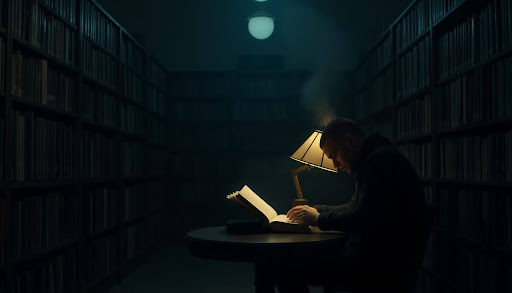The Saturday Night Ghost Club – A Review of Craig Davidson’s Novel
Imagine a summer filled with ghost stories, secret adventures, and the bittersweet pangs of growing up. In The Saturday Night Ghost Club, Craig Davidson captures those fleeting moments of childhood and the inevitable transition to adulthood. Through the eyes of Jake, a 12-year-old boy navigating the eerie mysteries of his small town, readers are taken on a journey that mingles nostalgia with the complexities of memory.
Davidson’s narrative, woven with vivid imagery and heartfelt introspection, invites readers to reflect on their own memories of youth. It’s a tale that resonates deeply, especially for those who remember wandering through urban legends and childhood fears. This book not only explores the innocence of childhood but also the haunting nature of what we leave behind as we grow older.
Join me as we unpack the layers of this coming-of-age story, spotlighting its rich themes of friendship, loss, and the power of storytelling. Whether you’re an avid reader or just starting your literary journey, The Saturday Night Ghost Club promises to be a book that lingers in your thoughts long after the last page.
Overview of the Novel
The Saturday Night Ghost Club is more than just a story about ghosts; it explores the intricacies of friendship and the experiences that shape us during our formative years. The novel dives deep into the life of Jake, a twelve-year-old boy living in 1980s Niagara Falls. Through ghostly adventures, Davidson paints a vivid picture of youth, nostalgia, and the haunting shadows of memory.
Main Characters
The characters in this novel are beautifully crafted, each one playing a significant role in Jake’s journey.
- Jake: The protagonist who narrates the story, Jake is an introspective boy grappling with the ups and downs of early adolescence. He finds himself in a series of spooky adventures that help him navigate the complexities of growing up.
- Uncle C: An intriguing figure in Jake’s life, Uncle C serves as a mentor and source of wisdom. His peculiar habits and ghostly tales captivate Jake, drawing him deeper into the club’s activities.
- Billy Yellowbird: Billy is the new kid in town and quickly forms a bond with Jake. His adventurous spirit adds excitement to their ghost-hunting escapades, making him an essential member of the group.
- Dove Yellowbird: Billy’s sister, Dove, brings a unique perspective to their adventures. She’s tough and independent, often challenging the boys’ notions of bravery and fear.
These characters not only enrich the plot but also highlight the themes of friendship, loss, and the resilience needed to face life’s uncertainties. Each character embodies distinct traits that resonate with readers, making them relatable figures in the narrative. For a deeper look into the character dynamics, check out this review.
Setting and Time Period
The setting of The Saturday Night Ghost Club is crucial to its narrative. Set in the vibrant yet haunting backdrop of 1980s Niagara Falls, the novel immerses readers in a world filled with nostalgic charm and eerie undertones.
- Niagara Falls: Known for its breathtaking beauty, the Falls also carry a certain mystique that captures the essence of childhood fears and curiosities. The local lore and urban legends that surround the area provide a rich tapestry for Jake and his friends to explore.
- 1980s Culture: This decade is characterized by a blend of innocence and burgeoning societal changes. The quirks of the time—such as video stores, cassette tapes, and the unique fashion—paint a vivid picture that enhances the narrative. The simplicity of life during this era allows for a focus on the friendships and adventures that define their youth.
The setting not only acts as a backdrop but also shapes the characters and their experiences. It emphasizes the importance of place in shaping memories that linger into adulthood. To learn more about how the setting influences the story, take a look at this insightful analysis.
Themes Explored in the Book
The Saturday Night Ghost Club by Craig Davidson intricately weaves several themes that elevate its narrative beyond mere ghost stories. Each theme connects to the personal experiences of the characters while highlighting universal truths about growing up, facing fear, and the relationships that define us. Let’s explore these themes in detail.
Nostalgia and Memory
Memory plays a pivotal role in shaping the narrative of The Saturday Night Ghost Club. Davidson delves into the world of nostalgia as Jake recalls his childhood, painting vivid images of his experiences. Through these memories, readers see how they can linger, often blurring the lines between reality and imagination. The bittersweet nature of nostalgia manifests in Jake’s character. He grapples with the impermanence of childhood while yearning to hold onto those innocent moments.
Jake’s memories often serve as a refuge from the harshness of growing up, and the ghosts he encounters symbolize the past that he wishes to preserve. They remind him that while time marches on, the essence of those moments can haunt one’s heart. This exploration of memory is not just personal; it resonates universally as we all navigate our own recollections of youth. For further insight on nostalgia in literature, check out this analysis.
Friendship and Growth
At the heart of The Saturday Night Ghost Club lies the theme of friendship. The bond shared among Jake, Billy, and Dove is beautifully illustrated as they navigate the trials of adolescence together. Their relationships evolve through shared experiences and challenges, showcasing the importance of companionship during this formative period.
Friendships in the novel are not just about laughter; they also carry weight as the characters confront personal struggles. For instance, Billy’s adventurous spirit encourages Jake to step outside his comfort zone, while Dove’s strong personality challenges traditional gender norms. This dynamic fosters growth, prompting each character to reflect on their identity and strengthen their resolve.
Through their adventures, Davidson captures the essence of what it means to support one another. The characters teach us that friendships can be a source of strength, shaping who we become. To explore more about the significance of friendship in literature, take a look at this article.
Facing Fears
A significant theme in The Saturday Night Ghost Club is the confrontation of fears—both personal and supernatural. Davidson presents fear as a complex, multifaceted experience. The characters face various fears, from the mundane anxieties of adolescence to the more profound fears surrounding loss and the unknown.
Jake’s ghost-hunting adventures serve as a metaphor for his internal struggles. By facing the ghosts of his childhood, he learns to confront the realities of growing up, acceptance, and change. The act of exploring haunted sites becomes a way to process fears that often go unspoken. It encourages readers to reflect on how confronting fears can lead to personal growth and empowerment.
This theme resonates universally, reminding readers that fear is an integral part of life. Through engaging with these fears, characters—and readers—discover pathways to bravery and resilience. For additional insights on tackling fears in literature, check out this resource.
Writing Style and Structure
Craig Davidson’s The Saturday Night Ghost Club showcases a unique blend of narrative techniques and a distinctive writing style that enhances the storyline. The way he crafts this tale not only draws readers in but also evokes a deep connection to the characters and themes.
Use of Language
Davidson employs descriptive language that brings the world of Jake and his friends to life. His careful choice of words enables readers to vividly imagine the eerie settings and the emotional landscapes that permeate the narrative. For instance, the descriptions of ghostly encounters are not merely spooky; they encapsulate the fascination and fear that accompany childhood adventures. This combination pulls readers into Jake’s experiences, making them feel as if they are alongside him, creeping into abandoned buildings or sharing whispered secrets by the campfire.
The way Davidson captures the essence of youth is particularly compelling. His language is both straightforward and layered, allowing younger readers to grasp the narrative while still engaging older audiences with its depth. Sentences are poignant, often imbued with reflective moments that resonate with anyone who has looked back on their own childhood. Davidson’s ability to strike this balance is part of what makes the writing relatable and engaging. For more insights into his writing, you can read a detailed review here.
Narrative Techniques
One of the most striking aspects of Davidson’s storytelling is the alternating perspectives of adult and child Jake. This technique adds depth to the narrative, allowing readers to experience both the innocence of youth and the reflective wisdom of adulthood. As the adult Jake narrates his childhood memories, the contrast between his youthful excitement and his current understanding creates a rich tapestry of emotion.
By presenting the story through these dual lenses, Davidson invites readers to see how memories can shift and evolve over time. Adult Jake often reflects on his childhood adventures with a sense of nostalgia and a hint of sadness, highlighting the complexities of growing up. This structure not only adds emotional weight to the story but also encourages readers to consider how their own memories shape their identity.
This narrative style also invites readers to engage in questions about memory and perception. What do we choose to remember? How do our experiences filter through the lens of time? These reflections elevate the story from a simple ghost tale to a profound exploration of life, loss, and the passage of time. For a closer look at this narrative technique, check out this analysis.
Comparisons to Other Works
The Saturday Night Ghost Club fits snugly within a genre that thrives on nostalgia and the bittersweet essence of growing up. Its rich storytelling mirrors other beloved narratives, showing that tales of childhood adventures resonate across different mediums.
Similarities to ‘Stand By Me’ and ‘Stranger Things’
When you think of classic coming-of-age stories, two prominent titles come to mind: Stand By Me and Stranger Things. Each of these works captures the nuances of childhood and explores friendships in the face of supernatural challenges. Similarly, The Saturday Night Ghost Club offers a delightful blend of heartfelt moments and eerie escapades.
One way these stories align is through their emphasis on childhood friendships. All three narratives portray tight-knit groups of kids facing their fears together and experiencing transformative adventures. In Davidson’s novel, Jake and his friends embark on ghost-hunting quests that echo the camaraderie seen in the journeys of the boys in Stand By Me and the gang from Stranger Things. There’s something universally appealing about young characters unearthing mysteries and confronting the unknown, making it relatable to readers of any age. For a more in-depth look at how The Saturday Night Ghost Club compares to these classics, check out this review.
Moreover, the tone in these stories often blends nostalgia with a sense of loss. As characters navigate some oddities in their lives, there’s an underlying acknowledgment that childhood soon gives way to adult responsibilities. Davidson beautifully captures this melancholy in his writing, as Jake reflects on his adventures and what they ultimately mean. This connection to the bittersweet nature of nostalgia ties all three narratives together, making The Saturday Night Ghost Club feel like a natural addition to this storied lineage.
As readers dive into Davidson’s world, they might find echoes of their own childhoods amidst the ghosts and friends. Whether through the lens of friendship, nostalgia, or facing fears, these stories remind us of the fleeting moments of youth that stay with us forever. If you’re interested in exploring the broader implications of nostalgia in literature, you might find this insightful piece on nostalgic narratives particularly engaging.
Critical Reception
Critical reception of The Saturday Night Ghost Club highlights its emotional depth and nostalgic themes. Many readers and critics appreciate Davidson’s ability to capture the essence of childhood through heartfelt storytelling. Various reviews reflect on the bittersweet nature of the narrative, emphasizing the nostalgia for simpler times.
Highlights from Reviews
Numerous reviews have praised the book for its relatable characters and engaging plot. Here are some snippets from notable reviews:
- “This book is pristine. The writing is crisp, the pages drip with nostalgia and emotion, and there are a few moments in here of genuine fright.” — Steve Stred
- “A short, irresistible, and bittersweet coming-of-age story… It’s a mix of humor and horror.” — Goodreads
- “It was a heartfelt and relatable story about growing up, while also exploring the power of memory.” — Muse With Me Blog
Overall, the reviews often highlight the novel’s ability to blend humor and nostalgia, making it appealing to a wide audience. Readers enjoy the mix of adventure and the deeper themes of growing up and facing fears, with some readers on platforms like Reddit commenting on its wistful tone without veering too heavily into horror.
Awards and Recognition
The Saturday Night Ghost Club has garnered recognition in the literary world. Notably, the book was shortlisted for the Rogers Writers’ Trust Fiction Prize, which honors outstanding Canadian fiction. This nomination underscores the quality of the writing and the importance of the themes explored.
Additionally, the novel is set to be included in the 2024 Dublin Literary Award ceremony, showcasing its international appeal and significance in contemporary literature. This kind of recognition not only highlights Davidson’s talent but also affirms the book’s place within the broader literary conversation.
For further insights about its literary accolades, check out the Dublin Literary Award page.
Conclusion
The Saturday Night Ghost Club is a refreshing blend of heartwarming nostalgia and the eerie mysteries of youth. Craig Davidson artfully captures the essence of growing up and the friendships that shape our formative years. Through Jake’s adventures, readers are reminded of the powerful connection between memory and identity.
This novel is more than just a ghost story; it’s a reflective journey that resonates with anyone who has ever faced the complexities of growing up. Dive into its pages if you’re looking for a tale that evokes both laughter and thought.
What moments from your own childhood continue to haunt you? Share your thoughts and let’s keep the conversation going! Thank you for reading.







